In the United States, there are over 40 types of termites. Worldwide there are more than 4,000. The US Department of Agriculture estimates that termites cause over a billion dollars of damage to homes in America every year. Crazy right? You obviously want to prevent termites before you end up with an infestation.
Termites all fall under one of the main four termite types.
These include the drywood termite, subterranean termite, dampwood termite, and formosam termite. While all under the termite umbrella, these species have some key differences that separate them. But before we get to that, let’s take a quick look at one of the main things termites have in common – their family structure.
The four members of a termite colony include nymphs, soldiers, workers and reproductives.
- Nymphs are the baby termites that haven’t yet been assigned a role and haven’t reached their full size.
- Soldiers are tasked with protecting the colony. Typically soldier termites make up less than 3% of their colony population. The soldiers have enlarged, darkened heads and enlarged jaws to help them fight off potential dangers.
- Workers are the backbone of the intrusion and make up the majority of it. It is their duty to build, manage and repair the colony when needed. They also help care for the young (nymphs) and the are responsible for foraging the food.
- Reproductives are winged and responsible for the reproduction process. Also known as swarmers, these termites have a darker body and long wings. After they leave their colony to mate, they start a new colony often in the role of king or queen.
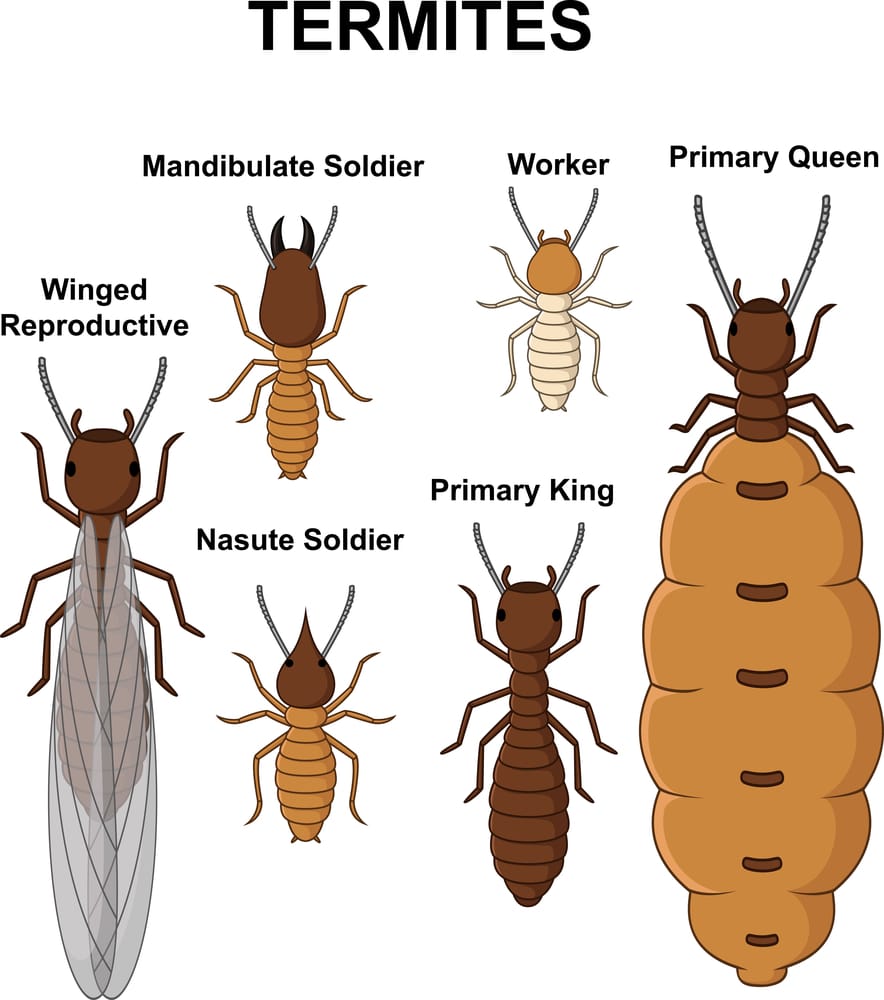
Now – back to the types of termites.
Drywood Termite
This is the most common type of termite that can be found throughout the world. As their name suggest, they live in drywood and eat through beams, walls, etc, until they are hollowed out. Unlike many other species, they can live in dry conditions for long periods of time and don’t need soil to survive. These termites are able to receive the moisture they need from the wood they eat.
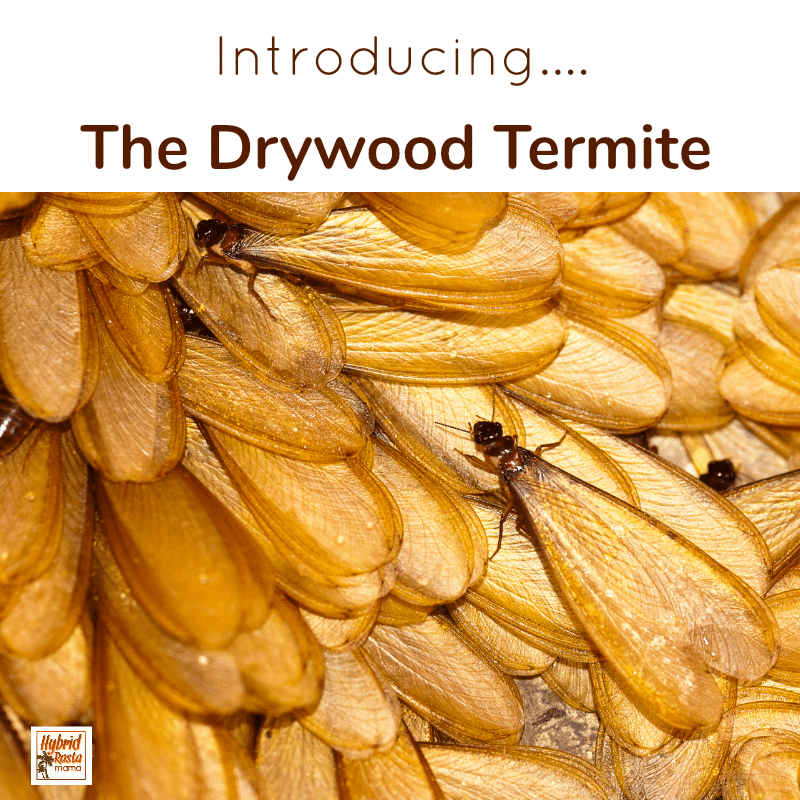
Drywood termite stats:
- Scientific name – Kalotermitidae
- Consist of more than 20 classes and about 350 types
- Creamy white to light brown in color
- Long, narrow, oval shape
- 3/8 – 1 inch long
Where they live:
- Primarily found coastally from South Carolina westward to Texas and up the west coast to California.
- Indoors: Dry wood (even wood that has been treated), framing, frames of windows, and furniture.
- Outdoors: Tree stubs, dead trees and even in dead branches of green trees.
Signs of a drywood termite infestation:
- Visible swarms of termites in or around your house
- Flying termites, also called alates, in or around your house
- Piles of frass, pellet-shaped termite feces, beneath “kickout holes” in wood
Subterranean Termite
This type of termite can only survive in the soil underground. Subterranean termites need high moisture levels. This species prefer to eat soft, spring wood fiber. They build mud tubes to contain the humidity levels necessary for survival. These termites construct mud tunnels on anything that comes into contact with the ground. Similar to drywood termites, subterranean termites are most common in warmer climates.
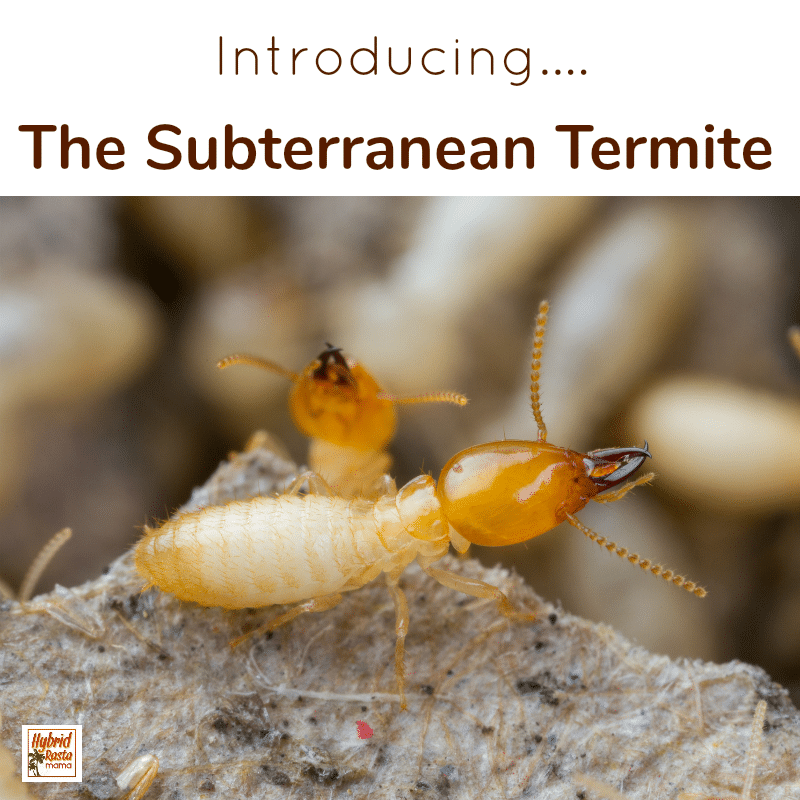
Subterranean termite stats:
- Scientific name – Reticulitermes flavipes
- Creamy white, grey white, dark brown, or black in color
- Long, narrow, oval shape
- 1/8 inch long
Where they live:
- Throughout most of the continental United States but prefer warmer climates
- In soil underground
- Any available wooden structure that comes in contact with soil
- Wherever there is moisture and darkness
Signs of an infestation:
- Raised mud tubes, the tunnel network used by the termites to find food and water
- Flying termites around the house after a rainstorm
- Piles of discarded termite wings around your house—they will be uniform in shape and size
Dampwood Termite
These termites live in wood with high moisture content and therefore don’t require contact with the soil to survive. Dampwood termites are mainly found in moist wood logs, stumps and dead trees and can sometimes be found near water leaks or wall voids, however termite infestations in buildings and structures are very rare. These termites are much bigger than the other species.
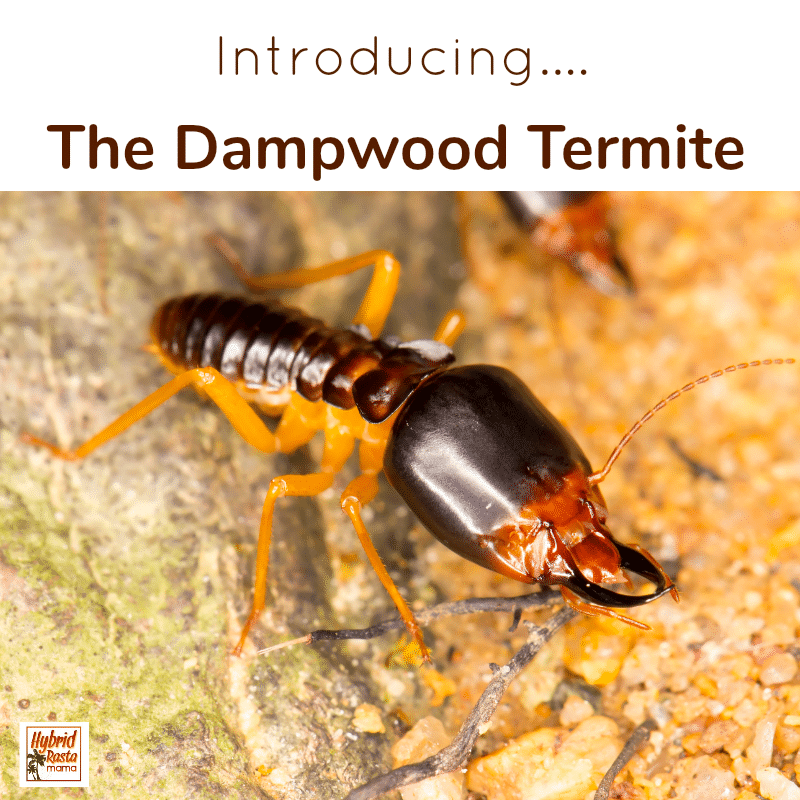
Dampwood termite stats:
- Scientific name – termopsidae
- Consists of 5 classes and about 30 types
- Creamy white to brownish in color
- Long, narrow, and oval shape
- ½ inch – 5/8 inch long
Where they live:
- Pacific Northwest, Desert areas, Semi-arid Southwest, parts of the Southeast, especially Florida
- Ares with high humidity
- Homes with serious moisture problems
- Untreated wood that touches the ground, such as piles of firewood
- Wooded areas with high moisture level, rotting stumps, dead trees
Signs of an infestation:
- Dead termites near the colony
- Soft spots in infested wood
Formosan termites
The Formosan termite is often called the “super termite” due to the rapid rate that colonies can destroy wood. A mature colony can eat about 13 grams of wood a day and can cause significant structure damage in as little as three months. Where Formosan colonies are present, nearby buildings are also at risk for invasion. Once Formosan termites have been established in an area, they are very difficult to eradicate. The queen in the colony can produce more than 1,000 eggs per day, and they eventually swarm to create new colonies.
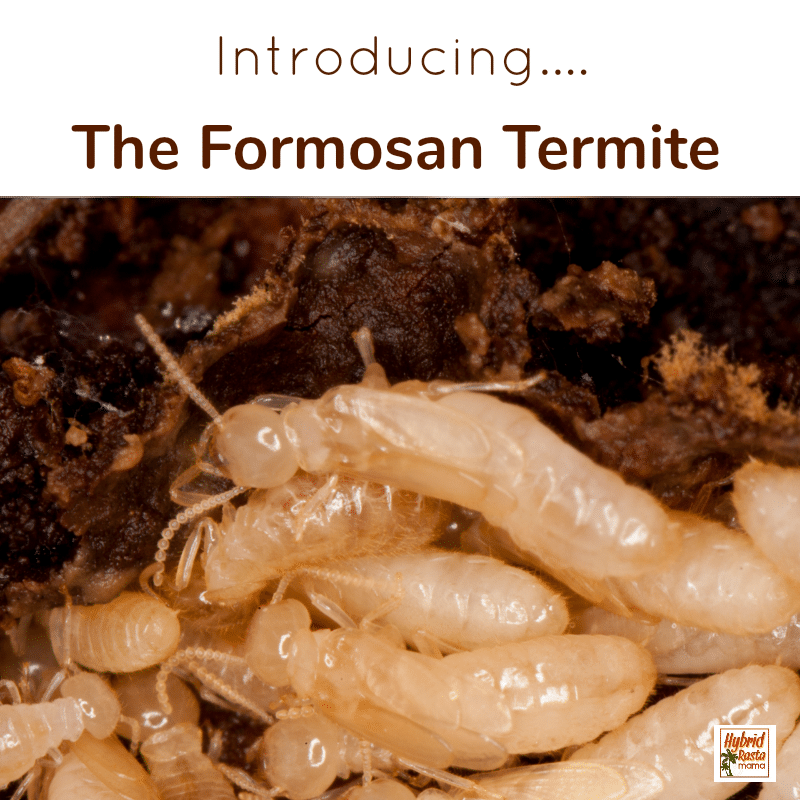
Formosan termite stats:
- Scientific name – Coptotermes formosanus
- Creamy white to brownish in color
- Long, narrow, and oval shape
- ½ inch long
Where they live:
- Mainly found in Hawaii, North Carolina, South Carolina, Georgia, Virginia, Texas, Louisiana, Alabama, Florida, Tennessee, and California
- All buildings
- Boats
- Trees
Signs of an infestation:
- Sagging walls
- Plaster and wood that appears to have been sanded down.
What About Desert Termites?
You caught me! I left out a pretty big category of termites. Why? Because desert termites do not pose a serious threat to properties. In fact, they bring more benefit rather than harm. By building channels in the ground these termites encourage water infiltration. They also break down plant material, as a result playing a big role in the environment.
Desert termites (Gnathamitermess) are more numerous than ants, though they are almost unnoticeable. Usually desert termites live underground, creating endless tunnels and channels. They can be found under rocks or wood.

Signs of a Termite Infestation In Your Home
While I made note of some specific signs of the four main types of termites, let’s take a big-picture view of how to spot a termite infestation in your home.
- Wood makes an empty, hollow sound when knocked on. Termites eat away at wood from the inside out, so if you notice this sound when knocking on your walls or doors, its time to get rid of termites naturally.
- Doors don’t close properly and windows stick. Termites eat the surrounding wood in doorjambs and windows, allowing water in and causing the structure to swell and weaken.
- Interior paint bubbles and peels from the wall. Termite-damaged drywall allows air and moisture to come between the surface and the paint—a tell-tale sign of an infestation. A word of caution – make sure that this is termite damage and not a water leak.
- You spot exit holes and termite droppings. If you find holes in your walls with small pellets of termite waste nearby, that’s a sign you have termites, specifically the drywood variety.
- Floors sag, walls buckle, and laminate tiles curl. Termites will eat away at a home’s structure and weaken integral components, resulting in compromised floor joists, drywall panels, and subflooring.
- You see mud tubes around your property. Mud tubes are tunnels that some types of termites use to transport food back to the colony. Mud tubes near your home’s foundation, windows, or any other surface are an indication of termites, likely from the subterranean family.
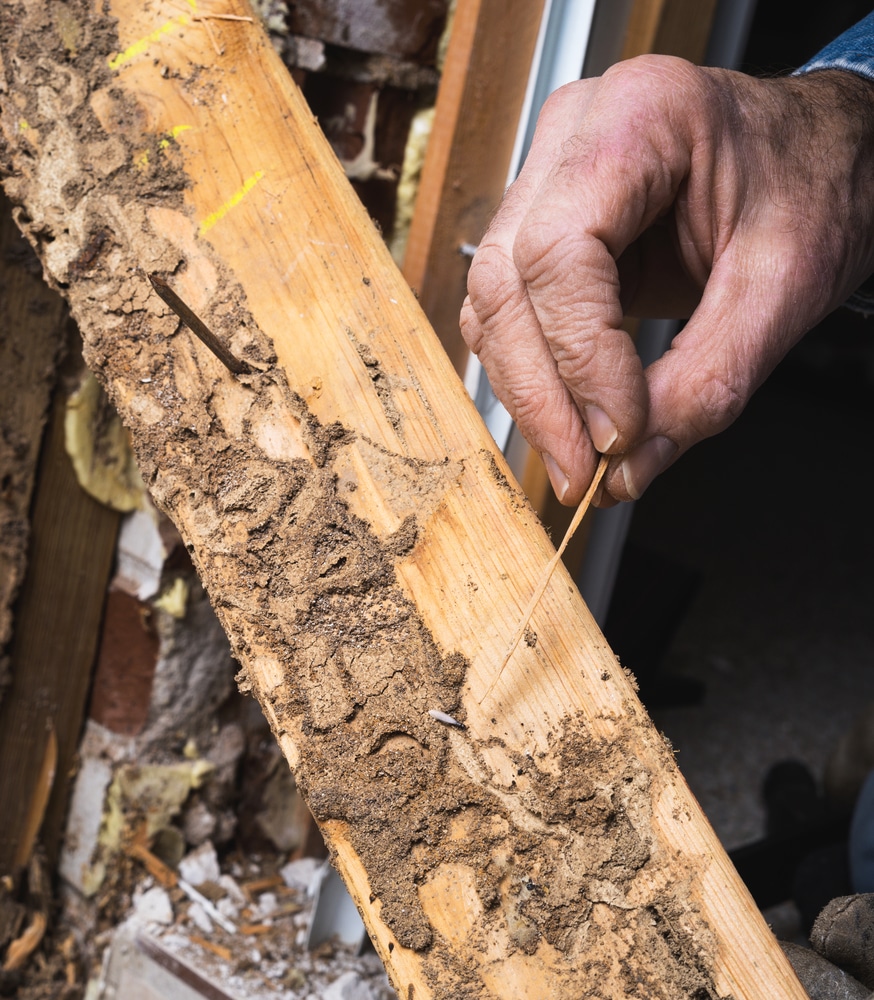
How To Get Rid Of Termites Naturally
You likely wouldn’t be here if you didn’t already have a termite problem. So let’s talk about how to get rid of termites.
The way you kill termites often times depends on the species although there are a few natural ways to get rid of termites that apply to all of them. Let’s take a look at those first.
Natural Methods To Get Rid Of Any Species Of Termite
Diatomaceous Earth: Fill a powder duster (like this one) with the diatomaceous earth. Apply the diatomaceous earth to form a barrier in areas such as exposed wood and insulation in your basement, attic, crawl spaces etc. You can also apply it directly on the soil of your garden. If you use it outdoors, you must reapply it each time it rains. If you are in a humid climate, you must reapply it every few days.
Aloe Vera: A solution of aloe and water repels termites, when sprayed in their area of activity.
Castor Oil: Mix castor oil seeds, leaves and roots with water and soak it for 24 hours. Then strain the solution and spray on the affected area to repel the termites. Don’t want to make your own castor oil solution? You can try this brand but making your own is more potent.
Poppy Oil: Spraying a mixture of poppy oil and water around the infested area keeps away termites. It also helps dry out any that come in contact with it. This is an affordable brand.
Boric Acid: This is considered to be the best ‘in between’ solution when it comes to the pesticides vs. natural solutions debate on pest control. After contact, it would take anywhere from 3 to 7 days for an exposed termite to die. My recommendation is Duda Energy’s Fine Powder Boric Acid. This is 99.9+% pure industrial grade boric acid and is an excellent value for money. To use boric acid, fill up a high quality powder duster with the boric acid powder. Simply use the powder duster to apply the boric acid powder into areas where you suspect the termites may be traversing like cracks or crevices. You can use this both indoors and outdoors, such as on your garden. If you manage to locate the termite colony, you can apply the boric acid powder directly into it.
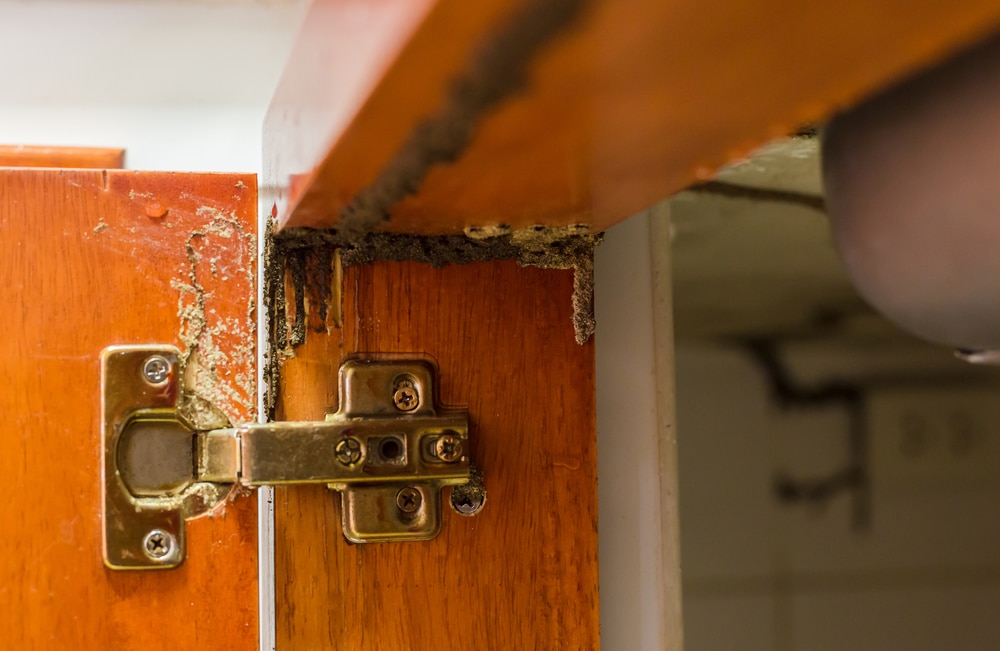
How To Get Rid Of Drywood Termites
Drywood termites are awful! I live in the desert and we battle termites. I have tried everything under the sun but natural remedies aren’t full proof typically. Here is what I have done that has helped though.
One of the greener options for termite control involves introducing parasitic roundworms into the termite colony. Also known as beneficial nematodes, these organisms can devastate termite populations. Once they’ve located and entered a host, these nearly microscopic worms release a bacteria that’s deadly to insects such as termites. Once they’ve killed their host they move on to another member of the colony, reproducing in the process. Beneficial nematodes can typically be found at your local home & garden store. Once purchased, release the nematodes into the termite hive and let them do the rest. This approach works best in conjunction with other natural pest control methods.
I only recommend NaturesGoodGuys Live Beneficial Nematodes! These have always worked VERY well and not just for termites. They attack fleas, flies, grubs and more.
Orange oil has proven effective at killing termites, particularly drywood termites. Extremely affordable and all natural, orange oil is derived from orange peels and is made mostly of d-limonene—a solvent that’s deadly to termites. When termites come into direct contact with orange oil their exoskeletons begin to dissolve, causing them to lose proteins and moisture, and ultimately die. This method works as a deterrent, too, as termites will avoid traveling in areas saturated with orange oil. Orange oil is also believed to disrupt termites’ pheromones, which they use to communicate. Simply spray full strength or mildly diluted orange oil onto termite problem areas, as close to the hive as possible. If the hive is located behind a wall and you’re not interested in tearing out Sheetrock, many professionals recommend drilling holes in the drywall and dispensing orange oil through the opening. (Always consult a professional before removing drywall or drilling holes for this purpose). Be aware: orange oil can irritate skin and cause complications if ingested, so please exercise caution when using this essential oil.
This is the best orange oil I have found.
How To Get Rid Of Subterranean Termites
Unfortunately, subterranean termites are very difficult to get rid of. The best way to kill a colony is with the trench method.
Dig a trench around your home 6 inches deep and 6 inches wide. Fill a bucket with equal parts salt and warm water. Yes, it should be very salty. Pour the mixture into the trench and immediately fill it back with dirt until it is turned into mud. Repeat the process for each side of your home until the entire perimeter of your home is covered. The termites will die of dehydration. You may need to repeat this process 2-3 times over the course of a 7 days period.
How To Get Rid Of Dampwood Termites
An effective way to get rid of dampwood termites is to make a cardboard trap.
Take two pieces of cardboard together, spray them with water until pretty wet but not falling apart, and leave them in infested area. It is like a cellulose-containing sandwich for dampwood termites.
Cardboard will attract fertile termites giving off an appealing woody smell. When termites fill the trap, take it away and burn. Now make a trap yourself again and wait for a new group.
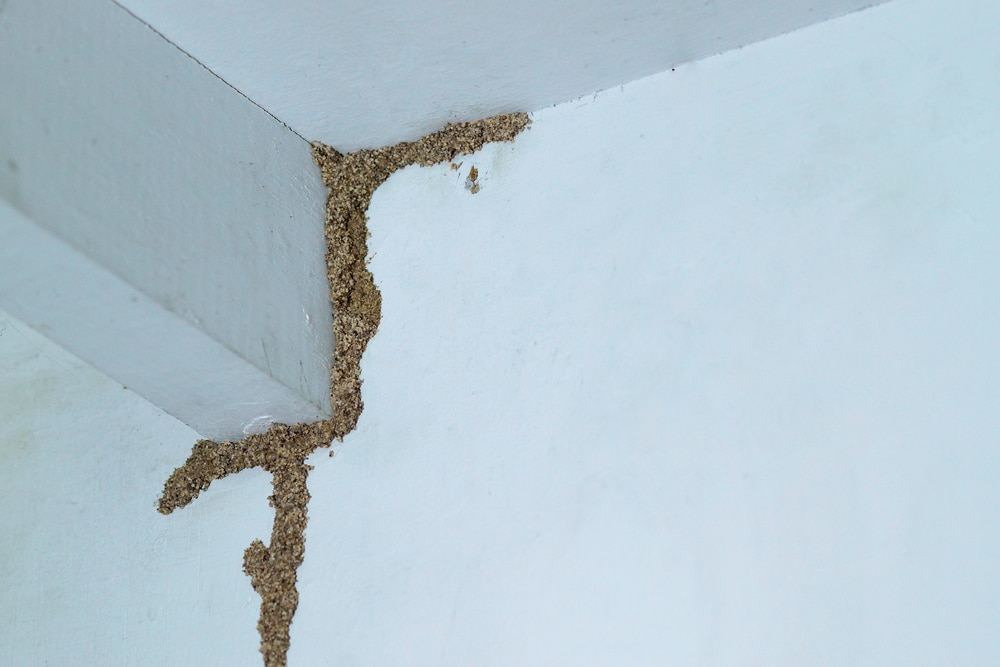
How To Get Rid Of Fosoman Termites
Termites of this type cannot survive under exposure to heat and light of the sun. Infested pieces of furniture, books, wooden frames can be taken outside during the hottest daytime in summer for 2-3 days.
Another method is to dig up a trench in infested area and leave to expose termite habitat directly to sunlight and heat.
Termite Prevention
One of the very best ways to prevent an infestation is to make your home’s wood unappetizing to termites. A wood treatment that removes moisture from wood is a highly effective method to deter termites from consuming or inhabiting wooden structures. This approach not only preserves wood—making it more structurally stable and resistant to rot and mold —but also transforms it into something termites can no longer eat or destroy. This is the product I use on all my outdoor wood structures.
Other ways to prevent termites include:
- Make sure your home has proper ventilation.
- Repair any leaky air conditioning units, sinks or faucets, as the moisture will attract termites and other pests. Better yet, prevent leaks in the first place.
- Avoid water accumulation near your home’s foundation. Divert water away with properly functioning downspouts, gutters and splash blocks.
- Reduce humidity in crawl spaces and attics as well as your entire home.
- Eliminate wood contact with the soil. Maintain a one inch gap between the soil and wood portions of the building.
- Keep firewood at least 20 feet away from your home.
- Clear away vegetation that can decay. This includes branches, twigs, fallen leaves, grass clippings, and the like.
- Remove any brush or heavy growth from around your home. Dense vegetation can create areas of intense moisture, which is necessary for colony survival. Plants plants at least 12 inches away from your foundation.
- Seal any cracks or holes within the foundation of your home. This will help prevent easy access for wandering termites.
- Use plastic for storage instead of wood.
- Apply Bora-Care directly to untreated wood surfaces. Formulated with a concern for the environment, Bora-Care is a borate based insecticide and fungicide that is used for the interior and exterior control of wood-boring insects. Its patented formula penetrates deep into the wood providing long lasting protection.
- Routinely inspect your foundation for signs of termite activity, including mud tubes.
And there you have it! Everything you need to know about how to get rid of termites, prevent termites, and some cool termite facts. So what are you waiting for? Go kill those termites today.
Have other pests you want to get rid of? Check out these reader favorites!
- Natural pest control for ants
- Natural pest control for cockroaches
- Natural pest control for mosquitos
- Natural pest control for flies
- Plus loads more can be found here
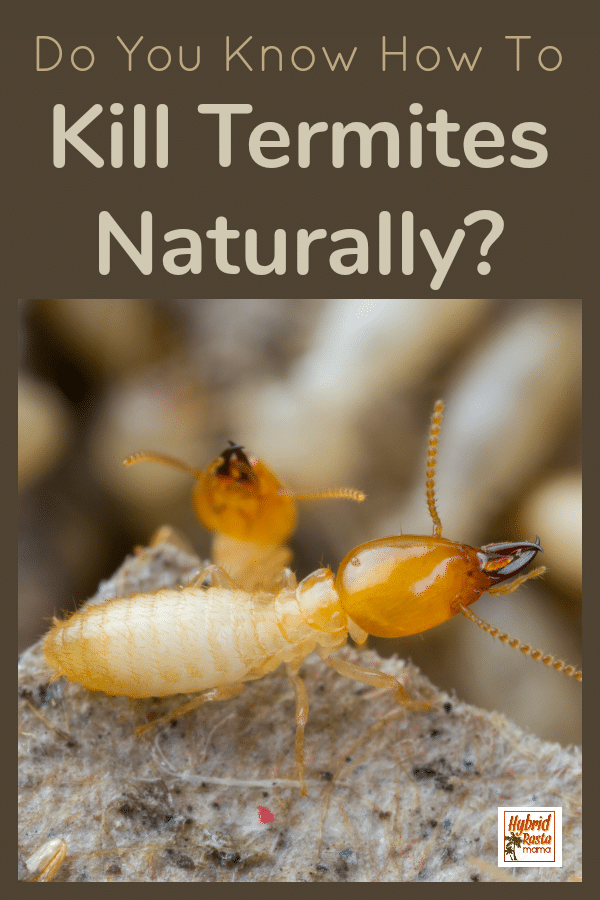



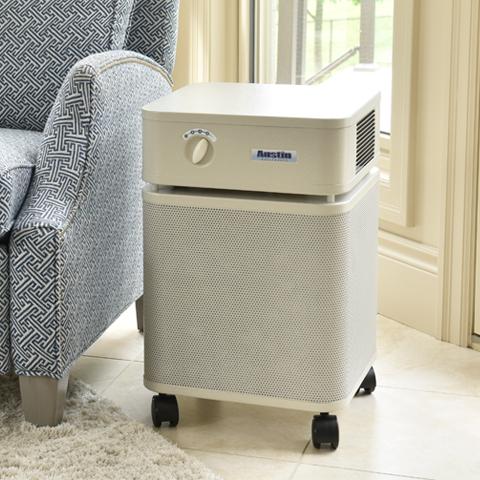

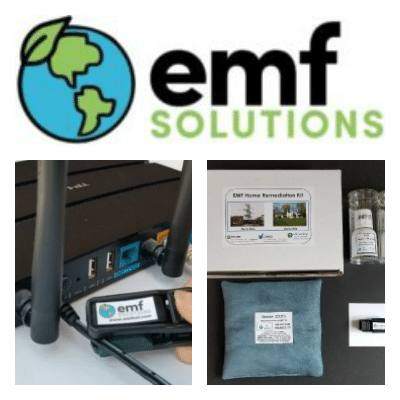


Afton Jackson says
It really helped when you talked about subterranean termites and how they can fly and leave discarded wings after a rainstorm. Just the other day, I was doing a complete house cleaning and I found what looked like insect wings around my window. I couldn’t exactly pinpoint where the source was, but this alarmed me enough to try and learn more about flying home insects. Now that I know that this can be a sign of a termite infestation, I’ll be sure to get a pest control service to stop by.
Darlin D. Aviles says
How do I know if I my bed has termites? Thank’s in advance!
Jennifer says
Are you referring to the mattress or the bed frame?
Zachary Tomlinson says
I never knew that some termites have strong enough wings to roam around properties and feed on their wood structures! I heard that my uncle is thinking of building a log cabin as his dedicated retirement space. I’ll be sure to suggest that he consult a pest prevention expert before he decides to move in.